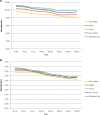Teaching hospital five-year mortality trends in the wake of duty hour reforms
- PMID: 23592241
- PMCID: PMC3710388
- DOI: 10.1007/s11606-013-2401-9
Teaching hospital five-year mortality trends in the wake of duty hour reforms
Abstract
Background: The Accreditation Council for Graduate Medical Education (ACGME) implemented duty hour regulations for residents in 2003 and again in 2011. While previous studies showed no systematic impacts in the first 2 years post-reform, the impact on mortality in subsequent years has not been examined.
Objective: To determine whether duty hour regulations were associated with changes in mortality among Medicare patients in hospitals of different teaching intensity after the first 2 years post-reform.
Design: Observational study using interrupted time series analysis with data from July 1, 2000 to June 30, 2008. Logistic regression was used to examine the change in mortality for patients in more versus less teaching-intensive hospitals before (2000-2003) and after (2003-2008) duty hour reform, adjusting for patient comorbidities, time trends, and hospital site.
Patients: Medicare patients (n = 13,678,956) admitted to short-term acute care non-federal hospitals with principal diagnoses of acute myocardial infarction (AMI), gastrointestinal bleeding, or congestive heart failure (CHF); or a diagnosis-related group (DRG) classification of general, orthopedic, or vascular surgery.
Main measure: All-location mortality within 30 days of hospital admission.
Key results: In medical and surgical patients, there were no consistent changes in the odds of mortality at more vs. less teaching intensive hospitals in post-reform years 1-3. However, there were significant relative improvements in mortality for medical patients in the fourth and fifth years post-reform: Post4 (OR 0.88, 95 % CI [0.93-0.94]); Post5 (OR 0.87, [0.82-0.92]) and for surgical patients in the fifth year post-reform: Post5 (OR 0.91, [0.85-0.96]).
Conclusions: Duty hour reform was associated with no significant change in mortality in the early years after implementation, and with a trend toward improved mortality among medical patients in the fourth and fifth years. It is unclear whether improvements in outcomes long after implementation can be attributed to the reform, but concerns about worsening outcomes seem unfounded.
Figures
Similar articles
-
Association of the 2011 ACGME resident duty hour reforms with mortality and readmissions among hospitalized Medicare patients.JAMA. 2014 Dec 10;312(22):2364-73. doi: 10.1001/jama.2014.15273. JAMA. 2014. PMID: 25490327 Free PMC article.
-
Mortality among hospitalized Medicare beneficiaries in the first 2 years following ACGME resident duty hour reform.JAMA. 2007 Sep 5;298(9):975-83. doi: 10.1001/jama.298.9.975. JAMA. 2007. PMID: 17785642
-
Mortality among patients in VA hospitals in the first 2 years following ACGME resident duty hour reform.JAMA. 2007 Sep 5;298(9):984-92. doi: 10.1001/jama.298.9.984. JAMA. 2007. PMID: 17785643
-
Patient safety, resident education and resident well-being following implementation of the 2003 ACGME duty hour rules.J Gen Intern Med. 2011 Aug;26(8):907-19. doi: 10.1007/s11606-011-1657-1. Epub 2011 Mar 3. J Gen Intern Med. 2011. PMID: 21369772 Free PMC article. Review.
-
The Interventional Arm of the Flexibility In Duty-Hour Requirements for Surgical Trainees Trial: First-Year Data Show Superior Quality In-Training Initiative Outcomes.J Surg Educ. 2016 Nov-Dec;73(6):e131-e135. doi: 10.1016/j.jsurg.2016.07.015. Epub 2016 Sep 16. J Surg Educ. 2016. PMID: 27651054 Review.
Cited by
-
Diagnostic Testing During Pediatric Hospitalizations: The Role of Attending In-House Coverage and Daytime Exposure.Acad Pediatr. 2020 May-Jun;20(4):508-515. doi: 10.1016/j.acap.2019.09.008. Epub 2019 Oct 21. Acad Pediatr. 2020. PMID: 31648058 Free PMC article.
-
Patient Safety Outcomes under Flexible and Standard Resident Duty-Hour Rules.N Engl J Med. 2019 Mar 7;380(10):905-914. doi: 10.1056/NEJMoa1810642. N Engl J Med. 2019. PMID: 30855740 Free PMC article. Clinical Trial.
-
Intrahospital Mortality Rate after the Implementation of the Second Phase of the Health Sector Reform in Comparison with Before that in Iran.Int J Prev Med. 2024 Aug 12;15:33. doi: 10.4103/ijpvm.ijpvm_288_23. eCollection 2024. Int J Prev Med. 2024. PMID: 39239299 Free PMC article.
-
Association of the 2011 ACGME resident duty hour reforms with mortality and readmissions among hospitalized Medicare patients.JAMA. 2014 Dec 10;312(22):2364-73. doi: 10.1001/jama.2014.15273. JAMA. 2014. PMID: 25490327 Free PMC article.
-
On Patient Safety: Have The ACGME Resident Work Hour Reforms Improved Patient Safety?Clin Orthop Relat Res. 2015 Nov;473(11):3364-7. doi: 10.1007/s11999-015-4547-8. Epub 2015 Sep 8. Clin Orthop Relat Res. 2015. PMID: 26349439 Free PMC article. Review. No abstract available.
References
-
- Kohn LT, Corrigan JM, Donaldson MS. To Err is Human: Building a Safer Health System. Washington: National Academy Press; 2000. - PubMed
-
- Accreditation Council for Graduate Medical Education. Resident duty hours language: Final requirements. 2003; http://www.acgme.org. Accessed February 18, 2013.
-
- Accreditation Council for Graduate Medical Education. Report of the work group on resident duty hours and the learning environment. June 11, 2002. In: The ACGME’s approach to limit resident duty hours 12 months after implementation: a summary of achievements, 2004. 2006; http://www.acgme.org/acgmeweb/Portals/0/PFAssets/PublicationsPapers/dh_d.... Accessed February 18, 2013.
Publication types
MeSH terms
Grants and funding
LinkOut - more resources
Full Text Sources
Other Literature Sources
Medical


